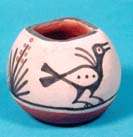Pueblo Pottery
Art Lesson Plan
Students will become familiar with the characteristics of Pueblo pottery. They will learn about the history and methods involved in the making of the pottery and its status today. They will create their own piece of pottery using modeling clay.

pieces of Pueblo pottery or pictures of pottery, modeling clay, tempera or acrylic paints, engraving tools: forks, nails, pencils, paper, colored pencils, books on Pueblo pottery such as: Fired Up! : Making Pottery in Ancient Times (Buried Worlds) by Rivka Gonen, Pottery (Usborne Guides) by Tony Potter, Children of Clay : A Family of Pueblo Potters (We Are Still Here) by Rina Swentzell, and Steps for Making Pueblo Pottery
- Bring in several pieces of Pueblo pottery and/or pictures of pottery.
- Have your class generate a list of features characterizing the Pueblo form of pottery. Some general characteristics include: earthy colors and tones, geometric lines and shapes, symmetry, etc.
- Have students share any knowledge they have about the Pueblo peoples. Also bring in information to share with the class such as books, articles, or videos. Locate areas on a map of the southwest United States where the Pueblo peoples are found. Pueblo is a term used to name many different tribes of Native Americans that live in pueblos ("village" in Spanish), which are compact, permanent settlements. You may want to create a KWL chart to record what the students Know already, what they Want to know, and what they Learned after your study about Pueblo lifestyle.
- Discuss with your students the change in the purpose for pottery throughout the history of the Pueblo Americans. For example, pottery used to be made for the sole purpose of storing goods, for cooking, and other practical uses. It has now become a large tourist market where individual pieces of pottery can sell for thousands of dollars—Pueblo pottery has entered the art market.
- Tell students they will be making their own pottery in the style of the Pueblos. Discuss the intricate process that Pueblos use in creating their pottery. Use the included information sheet to give your students an overview of the method. Then inform them that they will be getting just "a taste" of this method when making their creations.
- Discuss the importance of visualizing their completed their work before they actually start it. In order to do this, have students draw a picture of the pottery they would like to make, including colors, patterns, shape, etc. They can look at the samples and pictures for examples.
- Have students make their pottery using the modeling clay. If you have a kiln in your school, you should use regular modeling clay; however, if a kiln is not available to you, self-hardening clay is available. Give them a general idea of shaping the clay: start with a ball of clay and push with the thumbs in the center to form an opening in the clay and work from there, or roll the clay into "snakes" and curve it around and layer it to form a circular pot shape—smooth it afterwards using water.
- Let students use engraving tools such as forks, nails, pencils, etc. to create a textured surface if they desire.
- When students are happy with their work, let them dry or bake them in the kiln, depending on the type of clay used.
- When they are dry, let students paint them.
- Extension: You may want to convert your class a pottery museum and have other classes come to visit and see your students' work. The students can explain the process they used to the other classes.
 Have students share their completed pottery with the class discussing the method they used to create it, the chosen style, colors, and patterns. After all of the students have had a chance to share, have them reflect on their pottery-making experience as well as what they learned in general about the Pueblo peoples.
Have students share their completed pottery with the class discussing the method they used to create it, the chosen style, colors, and patterns. After all of the students have had a chance to share, have them reflect on their pottery-making experience as well as what they learned in general about the Pueblo peoples.Were the students able to characterize the Pueblo pottery? Did they include these characteristics in their own pottery? Were they able to summarize what they learned from the activity and discussions? Did they appreciate the Pueblo art form?


